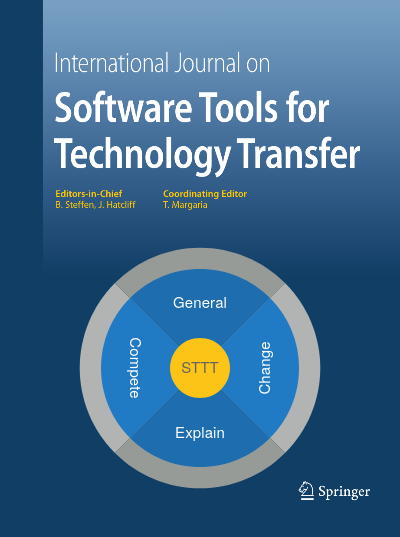STTT
International Journal on Software Tools for Technology Transfer

For Authors
Before preparing your manuscript, consult the Instructions for Authors on Springer’s STTT journal homepage and/or a copy of the journal to familiarize yourself with its formal and stylistic requirements: The manuscript should be written in clear and simple language. As STTT addresses quite a heterogeneous audience, a major selection criterion for papers and tools is a suitable and widely accessible presentation. The abstract, key words, and introduction should also be accessible to a wide audience.
Reviewing is organized via the editorial system Equinocs. The preferred submission format is PDF from LaTeX, but Word is also accepted. Authors who prepare their papers with LaTeX are encouraged to use this macropackage. Please note that also submissions have to be in the double-column format required for final versions.
Papers must be written in English. Authors whose mother tongue is not English are advised to seek the assistance of a native English speaker who is familiar with the topic of the paper.
Final Versions: After the manuscript is accepted, please submit also the final version of your article including LaTeX sources, figures, and the corresponding copyright form in electronic form via the STTT editorial service Equinocs.
Submission Initiation 🔗
Each article submission to STTT is initiated in one of the following ways:
- Open submissions: authors identify a relevant STTT Thematic Theme and submit a paper presenting research relevant to the selected Area. Authors may submit an open submission to an appropriate theme at any time. If, during the reviewing process a different theme seems to be more adequate, the authors will be contacted and asked for their willingness to change the area (and thus the editorial board) associated with their submission.
- Invited submissions: authors submit papers to Invited Issues in response to direct invitations or published calls from Invited Issue editors. Approval for Invited Issues and invitations/calls for Invited Issues must be given by the STTT Editors-in-Chief based on written proposals submitted by persons wishing to serve as Invited Issue Editors (see instructions below).
Presentation Approach and Expected Content 🔗
Style - As a forum for interdisciplinary technology transfer, STTT encourages an illustrative, example-driven presentation style that focuses on the underlying intuitions. Technical material and detailed proofs not necessary to understand the essence and the impact of the contributions should be replaced by adequate referencing of other publications or be provided separately as an online appendix. This way the journal allows a fast and intuitive entry into the new material and new themes, and at the same time the online appendix provides experts with easy access to related technical or theoretical details. These include proofs, definitions of complicated underlying calculi, and discussions of related theories, as well as other information concerning implementation issues, user documentation, benchmarking information, raw experimental data, which go beyond the general interest, as well as (software) artefacts enabling repeatability.
Emphasis: Many STTT papers will present the construction, application, or evaluation of one or more tools for software or system development. Important quality criteria for tool-oriented presentations are as follows.
- The tool is illustrated with clear and meaningful examples.
- The tool implementation is robust enough to be applied to realistic and interesting examples by others within the community.
- The presentation of the tool takes into account the broader development process and workflows that will typically be followed when using the tool; this might be supported by discussions that describe how the tool is used in conjunction with other development and quality assurance tools.
- The tool has been evaluated on a collection of examples and empirical results are presented to substantiate the claimed benefits of the tool as reported in the paper. When feasible, the experimental results should compare the performance of the presented tool to the results of other tools in the same space. Limitations of the tool should be clearly acknowledged.
- Ideally, the tool itself, examples, and evaluation results are publicly available for replicability – so as to enhance dissemination and cross-comparison of tools within the community.
Length: Submissions to the General Paper and Thematic Theme are typically 10 to 20 pages in Springer double-column format. Longer papers should be split into thematic subparts whenever possible
Example issues and concerns:
- Construction and analysis issues: This involves hierarchical and compositional approaches; syntax-oriented vs. semantic methods; synthesis vs. verification; formal support of the entire system lifecycle, including requirements capture, design, implementation, verification, testing maintenance, evolution; analysis of non-functional aspects of system behavior, such as real-time, probability, and efficiency.
- Practicality issues: This addresses performance, genericity, and usability of tools; case studies and experience reports; industrial use and feedback.
- Generic tool issues: Those include paradigms (fully automated vs. interactive approaches); design issues (modularity, efficiency, portability, integrability, reusability); automatic support (tool generators, integrators, and interface builders); user interfaces (graphics, Web forms, retrieval).
- Meta issues: How can methods and tools be evaluated/compared, and how can they be evolved, combined, and integrated.
Reviewing Process 🔗
Once an Open Submission is received via the web-based STTT submission service, the submission will be reviewed for general suitability for STTT by the Editors-in-Chief. Papers deemed unsuitable due to scope or content issues may be rejected without further review. Suitable papers are delegated to an appropriate Area Editor who manages the selection of reviewers, assesses the results of reviews, and makes decisions regarding paper revision and final acceptance. The STTT Office supports the designated editor by handling communication with authors and reviewers.